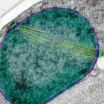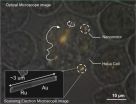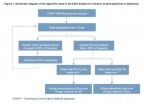(Press-News.org) KANSAS CITY, MO—Researchers at the Stowers Institute for Medical Research have glimpsed two proteins working together inside living cells to facilitate communication between the cell's nucleus and its exterior compartment, the cytoplasm. The research provides new clues into how a crucial protein that is found in organisms from yeast to humans does its work.
The study, led by Stowers Investigator Sue Jaspersen, Ph.D., focused on a protein called Ndc1, which controls when and where a cell inserts holes into the double-walled membrane that surrounds its nucleus. In yeast, these holes become the sites for two essential structures: passageways called nuclear pore complexes, and spindle pole bodies, which anchor the cytoskeletal filaments that pull chromosomes to opposite sides of a dividing cell.
"Too many or too few insertion sites will have disastrous consequences," Jaspersen says, explaining that new nuclear pore complexes and spindle pole bodies must be created each time a cell prepares to divide to ensure genetic material can be properly distributed and daughter cells are equipped for gene activation and protein production. Her team's findings on Ndc1's interactions with a protein called Mps3, which appears to govern Ndc1's distribution on the nuclear envelope, are described in the February 10, 2014 issue of the Journal of Cell Biology.
Jaspersen and her colleagues set out to study Ndc1 because it is absolutely crucial for cell survival. They knew that in yeast, Ndc1 is embedded in the nuclear envelope and is needed for the insertion of both nuclear pore complexes and spindle pole bodies. But because cells are so sensitive to changes in Ndc1, scientists had been unable to learn much about how the protein functions.
Traditional genetic strategies of eliminating, altering, or increasing Ndc1 to test its function typically killed cells. "Having the exact right amount of Ndc1 is really critical," Jaspersen says. "That makes working with the gene very technically challenging. So we knew it was really important and the amount was really important, but we didn't know what it did or why it did it."
To learn more, Jaspersen and Jingjing Chen, a postdoctoral researcher in her lab, created yeast with mutations in the ndc1 gene. As expected, changes that disrupted Ndc1's interaction with its known partners in the nuclear core complex or the spindle pole body were lethal. One mutation puzzled the scientists, however. The altered Ndc1 protein bound to the expected components of both the nuclear pore complex and the spindle pole body, just like the normal protein. "Previous data suggests that if Ndc1 can functionally bind to these components, both the spindle pole body and the nuclear pore complex should be fine," Chen says. But when yeast cells produced this altered version of Ndc1, they died. "So this suggests that there may be another very critical interaction partner," she says.
Chen devised a strategy to search for such a partner. She turned to a method called a yeast two-hybrid assay, in which researchers link the proteins they are testing to two different parts of a gene activator. If the proteins associate with one another inside the cell, they bring along the gene activator components, allowing them to work together to switch on an easily detectable gene. Using a membrane-based yeast two-hybrid assay, which could detect interactions at the nuclear envelope, Chen found that Ndc1 bound to a protein called Mps3.
Jaspersen had first encountered Mps3 in 2002, when she discovered that yeast needed the protein to duplicate their spindle pole bodies prior to cell division. Mps3's interaction with Ndc1, however, was a surprise.
The institute's molecular microscopy research advisors, Brian Slaughter, Ph.D., and Jay Unruh, Ph.D., proposed that the team use a sophisticated imaging technique called fluorescence cross-correlation microscopy to look directly at the Mps3 protein inside living cells and watch for its interactions with Ndc1. To monitor Mps3's interaction with Ndc1, the researchers attached a fluorescent red tag to Ndc1 and a fluorescent green for Mps3. They then focused their microscope on a specific point within a living cell, and watched for green- or red-tagged proteins to enter or leave that space. Their observations would reveal whether Ndc1 and Mps3 were moving independently within the cell, or whether they were physically linked.
"This allowed us to look inside living yeast cells to study the complexes in real time, in the context of the nuclear envelope. We could just sit there and watch, rather than touching or breaking open the cells," Jaspersen says. The imaging not only confirmed the interaction between Mps3 and Ndc1, it allowed the team to track exactly where it occurred.
Although she and her colleagues expected to see Mps3 associate with Ndc1 either at nuclear pore complexes or at the cell's spindle pole bodies, neither turned out to be true. Instead, Mps3 and Ndc1 came together in the nuclear envelope, but away from the two structures the team had set out to study. This led them to speculate that Mps3 might help shuttle Ndc1 to the sites where it is needed, controlling the distribution of nuclear pore complexes and spindle pole bodies. Jaspersen team is now planning further experiments to test how Ndc1 and Mps3 maintain the appropriate balance of these critical structures.
INFORMATION:
Christine J. Smoyer, a predoctoral researcher in the Jaspersen lab, also contributed to the work.
The work was funded by the Stowers Institute for Medical Research and the American Cancer Society.
About the Stowers Institute
The Stowers Institute for Medical Research is a non-profit, basic biomedical research organization dedicated to improving human health by studying the fundamental processes of life. Jim Stowers, founder of American Century Investments, and his wife, Virginia, opened the Institute in 2000. Since then, the Institute has spent over 900 million dollars in pursuit of its mission.
Currently, the Institute is home to nearly 550 researchers and support personnel; over 20 independent research programs; and more than a dozen technology-development and core facilities.
Conserved nuclear envelope protein uses a shuttle service to travel between job sites
2014-02-10
ELSE PRESS RELEASES FROM THIS DATE:
Weakness exposed in most common cancer gene
2014-02-10
NYU Langone Medical Center researchers have found a biological weakness in the workings of the most commonly mutated gene involved in human cancers, known as mutant K-Ras, which they say can be exploited by drug chemotherapies to thwart tumor growth.
Mutant K-Ras has long been suspected of being the driving force behind more than a third of all cancers, including colon, lung, and a majority of pancreatic cancers. Indeed, Ras cancers, which are unusually aggressive, are thought of as "undruggable" because every previous attempt to stall their growth has failed.
Reporting ...
Transcendental Meditation significantly reduces PTSD in African refugees within 10 days
2014-02-10
African civilians in war-torn countries have experienced the threat of violence or death, and many have witnessed the abuse, torture, rape and even murder of loved ones. Many Congolese living in Ugandan refugee camps are suffering from severe posttraumatic stress disorder (PTSD).
New research shows that Congolese war refugees who learned the Transcendental Meditation® technique showed a significant reduction in posttraumatic stress disorder in just 10 days, according to a study published today in the February 2014 issue of the Journal of Traumatic Stress (Volume 27, ...
Nanomotors are controlled, for the first time, inside living cells
2014-02-10
For the first time, a team of chemists and engineers at Penn State University have placed tiny synthetic motors inside live human cells, propelled them with ultrasonic waves and steered them magnetically. It's not exactly "Fantastic Voyage," but it's close. The nanomotors, which are rocket-shaped metal particles, move around inside the cells, spinning and battering against the cell membrane.
"As these nanomotors move around and bump into structures inside the cells, the live cells show internal mechanical responses that no one has seen before," said Tom Mallouk, Evan ...
Matchmaking this Valentine's Day: How it can bring you the most happiness
2014-02-10
Austin – February 10, 2014 – With Valentine's Day around the corner, you may be thinking of pairing up two friends for a date. If you follow your instinct to play Cupid, it'll pay off in happiness – not necessarily for the new couple, but definitely for you.
According to new research, matchmaking, a time-honored tradition, brings intrinsic happiness to the matchmaker. To maximize the psychological benefits of matchmaking, you should take care to introduce two people who not only seem compatible but who would be unlikely to meet otherwise, researchers say.
"At some point, ...
Genetic discovery to keep crops disease-free
2014-02-10
Curtin University researchers have found a way to breed disease-resistant wheat with no downside, potentially bringing multi-million dollar savings to Australia's agricultural industry.
According to John Curtin Distinguished Professor Richard Oliver, Director of the Australian Centre for Necrotrophic Fungal Pathogens (ACNFP) at Curtin, farmers can lose more than 0.35 tonnes per hectare in wheat yields to Yellow Spot, even after applying fungicide.
For an average-sized farm of 4000 hectares, this could mean an almost $500,000 loss to disease per year – or about $212 ...
Slowing down the immune system when in overdrive
2014-02-10
Many people suffer from chronic inflammation because their immune systems overreact to 'self' tissue. Sydney scientists believe that a small molecule known as Interleukin 21 is a promising therapeutic target in such cases.
Interleukin 21 (IL-21) is one of a group of chemical messengers known as 'cytokines', which affect the behaviour of immune cells. IL-21 is already well known to play an important role in autoimmune diseases such as Sjögren's syndrome and type 1 diabetes.
The current study shows how much IL-21 contributes to inflammation. It also shows how important ...
When you always gotta go…
2014-02-10
Problems related to urination, including incontinence and having to get up to urinate at night-time, have become more acceptable topics of discussion over recent years. New treatment options have also led doctors to address these symptoms more actively. Despite this, no study has effectively compared the bother of each of these bladder symptoms for men and women of all ages.
The FINNO Study is an ongoing questionnaire survey conducted right across Finland. A random sample of 6,000 adults identified from the Finnish Population Register, were contacted with a questionnaire ...
New trial results affirm better blood pressure management during C-section
2014-02-10
10 February 2014, Singapore: New trial results1 have shown that the world's first Double
Intravenous Vasopressor Automated (DIVA) System affords superior control of maternal blood pressure in women undergoing caesarean section under spinal anaesthesia, when compared with manually-administered medication to manage reduced blood pressure (vasopressor).
Developed by doctors at KK Women's and Children's Hospital (KKH), the novel DIVA System detects and responds rapidly to low blood pressure and/or slow heart rate in real time by auto-administering a precise amount of the ...
Normal enzyme aids a mutant 1 to fuel blood cancer's growth
2014-02-10
BOSTON (Feb. 10, 2014)—Reinforcing the need to look beyond genomic alterations to understand the complexity of cancer, researchers from Dana-Farber/Boston Children's Cancer and Blood Disorders Center report that a normal enzyme called SYK pairs with FLT3, the most commonly mutated enzyme found in acute myelogenous leukemia (AML), to promote progression of the disease. This molecular partnership also promotes AML cells' resistance to treatment with FLT3-blocking drugs, potentially explaining the relatively poor showing of FLT3 inhibitors in multiple clinical studies. In ...
Flat-pack lens boosts solar power
2014-02-10
Micro-machining could be used to create almost flat, Fresnel lenses, that boost the electrical efficiency of solar panels, according to researchers in China.
Fresnel lenses were invented by French engineer and scientist Augustin-Jean Fresnel, in the early nineteenth century, they are essential two-dimensional equivalents of conventional optical lens, but they have ridges in concentric rings that focus the light to a point behind the lens without the three-dimensional bulk of a conventional lens. Image quality is reduced when using a Fresnel lens to focus because the concentric ...




